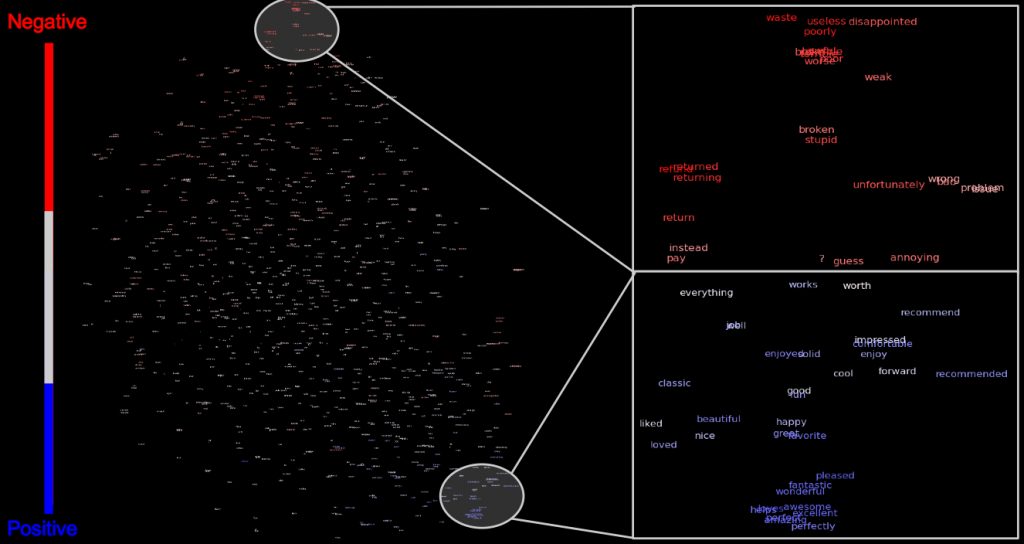You may have heard the term “machine learning” being thrown around, but what exactly does it mean? It’s a broad term referring to a class of computer algorithms that allow machines to perform general tasks, such as identifying human faces in photos. These algorithms build mathematical models from an initial dataset (known as a training dataset) that computers use to make predictions and decisions. We can then use these predictions to solve real world problems, such as understanding the emotions displayed on a person’s face when they’re viewing a new advertisement or testing a new product.
A visualization of how computers perceive feelings in words, taken from a presentation by Alec Radford
Machine learning enables automated, more efficient predictive analytics. Instead of hiring 100 people to analyze 1,000 data points each, a single machine can do it all in a fraction of the time. This also adds increased reliability because there’s a reduced chance for human error when processing results.
Machine learning is (probably) older than you
Although many people believe machine learning is a new technology, it’s actually an established field of academic research that has recently experienced a boom in commercial applications. Alan Turing and Arthur Samuel were two of the first scientists to explore the field in the 1950’s. Samuel built the very first computer program that could play checkers in 1952. He eventually taught it to play checkers so well that it went on to win the World Checkers Championship multiple times, and was recognized in the Guinness Book of World Records as the first computer to win a human championship.
Since then, many applications of machine learning, including speech recognition and computer vision, have made their way from academic research to industry. However, machine learning has historically had high barriers to entry such as expertise in the field, large amounts of capital, special infrastructure, and lengthy construction time. As a result, the technology was only accessible to large enterprises with the resources to support it.
Bigger insights for smaller businesses
In today’s digital landscape, where huge amounts of data are sent and shared around the world every second, you now have access to a wealth of information that could be used to fuel business intelligence. However, without the right tools or resources to create them, it’s difficult for startups and medium-sized businesses to tap into the full potential of that information. Consequently, machine learning as a dedicated service has become widely available, with many firms working to create user-friendly tools for improved, automated, and cost-effective predictive analytics. We see machine learning being used today in a range of applications, from understanding how much people like your product to self-driving cars to medical diagnostics.
It’s no longer the case that large corporations monopolize the space. Through firms like indico that provide machine learning as a service, you can make use of this powerful technology to quickly turn raw data into human insights. With this information, you’ll be better equipped to improve your products, customer relationships, user experience, business strategy, and ultimately, your brand.
If you’re interested in learning more, check out our other articles in The Founder’s Guide to Machine Learning series: Why You Shouldn’t Build Your Own Models and Choosing the Right Service for Your Business.
Or, empower your business with machine learning now at indico.io.
References:Applications of Machine Learning and Rule Induction
by Pat Langley and Herbert A. Simon
Machine Learning and Optimization by Andres Munoz
The Discipline of Machine Learning by Tom M. Mitchell



